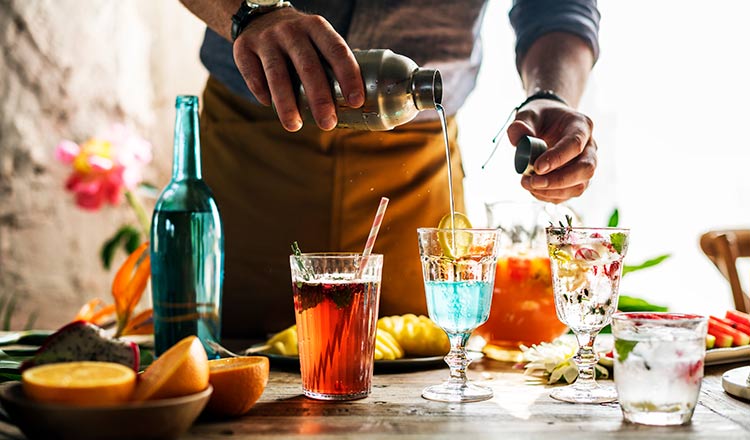With all the cocktail choices out there, being prepared to make even a simple drink for your friends after work can seem like a daunting task. So, more often than not, we end up defaulting to wine or craft brews. But sometimes the intrigue of ice clinking in the glass, the idea of fresh lime juice awaiting a rum drink, and the wonderful Hollywood way an oversized cocktail glass feels in your hand makes you want to start mixing drinks.
If you’re ready to add mixed drinks to your repertoire, here are some simple suggestions for creating and stocking your own home bar.
Where to Start
Every bar has a personality based on the tastes and preferences of the bartender. That’s because each liquor comes with its own characteristics and ingredient partners that will lead you to taste, test, and then stock your home with the ones that appeal to you. So find the base spirit that you like and begin from there. Bourbon, rum, apéritifs, cordials… all play a lead or supporting role in their own list of classic and new drinks.
Recipes
Just as you collect recipes for dinner, so you’ll begin to amass them for your bar, from magazines, cocktail books, and your favorite bartenders. Eventually, you’ll learn to use cocktail recipes as a jumping-off point for experimentation.
The Well
Spend your bar dollars wisely by stocking up on the basics. Spirits for the standard bar should be good quality—maybe a step up from the ones in plastic bottles, but not so expensive that it would be a crime to put a little juice and soda in them. You should be able to buy most items in a standard “well” (as it’s called behind the bar) in a 750ml bottle for about $30.
From there, purchase ingredients for the things you like to drink:
- A mild orange-flavored liquor, such as triple sec, if you like margaritas,
- Some small bottles of vermouth (which has a shorter shelf life since it’s wine-based and will keep for just a couple of months in the refrigerator after opening) if you like a Martini or Manhattan, or
- Specific brands and styles such as Campari for Negronis (or Boulevardiers) or absinthe if you plan on trying out some Sazaracs.
Luckily, many items from the bar are also used in cooking, so there’s another way of using what you buy instead of letting the bottles collect dust or dumping all the contents into a big boozy punch (not that there’s anything wrong with that).
Mixers
Mixers constitute just about everything in your glass except the alcohol:
The Usual Suspects
Small bottles of tonic water, ginger ale or ginger beer, and soda water (sparkling mineral water in a pinch) are ideal because they keep well and store easily. Unless you have a serious G&T habit, two-liter bottles will just go flat.
Juices
For most juices—lime, lemon, orange—fresh is always best. So keep a small bowl of fresh fruit handy in the kitchen for cocktail emergencies and some colorful décor. You’ll also need it for an aromatic peel if called for as a garnish.
Garnishes
Speaking of garnishes, this is an area where we tend to splurge: good pitted green olives for a Martini, Italian Amarena cherries for Manhattans, fresh mint from a pot for the mojitos. Again, these are all ingredients you can also use for cooking to keep them from languishing in the bar storage too long.
That Extra Something
You may want to invest in flavored syrups for your bar—Orgeat for a Mai Tai and Rose’s Lime for a proper gimlet. A small container of superfine sugar is also a good idea.
Bitters
What spices are to a dish or jewelry is to a wardrobe, bitters are to a cocktail. As one of the fastest-growing trends in modern mixology, bitters are now available to consumers in a variety that’s just short of staggering. These little bottles pack a big punch of flavor, providing the perfect “seasoning” in just a couple of dashes and adding layers of flavor, from herbal to fruity to spicy to bitter.
Angostura is called for in a number of recipes beyond the Manhattan, Old Fashioned, and Champagne cocktail, so you’ll need a small bottle of that. And there are also seemingly endless flavors from a dozen or so specialists popping up all over the country, including peach, celery, chocolate, lavender, and barrel-aged. Find a couple that are intriguing to you and join the club.
Ice
Finally, good ice is a must. In any drink that is stirred or shaken with ice, water becomes an ingredient and therefore a flavor in the drink. For that reason, fresh, clean-tasting ice cubes are crucial.
Size matters with ice, because smaller pieces melt quickly and don’t allow for enough stirring or shaking time before diluting the drink. If your recipe calls for crushed ice, most modern blenders can handle the job.


